Freezing food is a method of preserving a meal from preparation to eating. Farmers, trappers, fishermen, and other farmers have used this method to protect their foods since early times. Whether it’s grains, fish or fruit, the freezing process helps to keep these items fresh.
 Ice crystals on ice cream
Ice crystals on ice cream
Ice crystals on ice cream may not be the first thing that pops into your head, but they are a definite possibility. Luckily, some nifty tricks can help keep your ice cream cool and fresh longer. Here are some of them. Check out MarkwellFoodsNZ.
A good rule of thumb is to ice your ice cream in the freezer to prevent it from melting. Another way to prevent ice cream from melting is to use a cling film. Place a small cling film on the outside of your ice cream and gently press it onto the surface. Once the ice has formed, remove the cling film and place the ice cream in the freezer.
If you find yourself eating melted ice cream, you should reconsider your decision. Not only is melted ice cream a bit icky, but it also increases your chances of contracting a foodborne illness. Eating melted ice cream can cause stomach cramps and diarrhea, often the symptom of a more severe problem.
When it comes to ice cream, there are no foolproof ways to prevent your ice from melting. The best option is to use a plastic container to insulate the ice cream from absorbing moisture. You can also keep the ice from getting too cold by upside down the ice cream in the freezer.
There is one other ice cream-related trivia to remember: frozen ice cream may thaw if the cold chain is disrupted. However, some ice cream is too icy to be eaten, so check the expiration date before purchasing your next batch.
Air-blast freezing
Air-blast freezing of frozen food is an effective and economical method of freezing various foods. It is also safe and hygienic. The process is characterised by a strong stream of icy air blown at high speeds over products.
Air blasting was a popular method for quickly freezing food until mechanical refrigerators’ advent. Today, it is a widely used technique.
One of the advantages of blast freezing is that it reduces the risk of bacteria growing in the product. In addition, compared to regular freezers, which typically take six to twelve hours to freeze a food item, the faster process results in a smaller ice crystal formation, which helps keep the original taste and texture of the food.
The best way to freeze a food item is to freeze it at the correct temperature. Properly frozen foods can be stored at a temperature between 0 and -20 degrees Celsius. A good blast freezer can reach this temperature in a few hours.
A typical blast freezer has a fluidised bed and a circulating air system. It ensures that the air in the freezing chamber is constantly in motion, resulting in a more uniform air temperature.
An ideal blast freezer should be designed to minimise the risk of bacterial growth. Two ways to do this are by controlling the airflow or removing the product from the blast chamber.
A properly designed and constructed blast freezer can help increase your chef’s menu options while reducing waste. However, care must be taken to avoid design flaws that could cause uneven product freezing.
In addition, proper ventilation and a well-insulated box are essential to maintaining an appropriate balance of cooling. However, these items can be a challenge to achieve, especially if the food is packed tightly.
Plate freezers
Plate freezers are efficient and versatile freezing machines. They have high freeze capacities, a small footprint, and easy installation. Among many industries, they are used for freezing ready-to-eat food, seafood, and secondary products before further processing.
Foods in a plate freezer are positioned between two metal plates. These plates are cooled using refrigerants, brine, and CO2. The uniform temperature is beneficial for freezing and preservation.
Plate freezers have an insulated design, making them energy efficient. In addition, stainless steel is an easily maintained material. It minimises the overall environmental impact.
Several benefits of using plate freezing include lower costs, improved quality, and energy efficiency. The process is also environmentally friendly, as it uses less refrigerant.
Maxson Whirlwind Oven
The Maxson Whirlwind Oven is a convection oven used to cook frozen food. It has a fan in the back of the appliance that circulates air around the food. It ensures even cooking and avoids heat concentration.
The oven was initially made of aluminium and steel and weighed thirty-five pounds. It was designed to cook six meals at a time. After World War II, it was replaced by microwaves and convection ovens.
When the Maxson Whirlwind Oven was first introduced, it had a fan in the back of the unit to spread hot air evenly over the food. It was powered by electricity or gas.
It was designed to speed up the cooking of frozen food. As a result, it could cook six frozen meals in fifteen minutes, compared to half the time it would take to cook in a conventional oven.
Aside from cooking, the Whirlwind Oven also defrosted the Sky Plates. In the past, the Navy used cold sandwiches and K-rations for its service members. However, with the introduction of the Whirlwind, the meals were defrosted quickly and prepared for the service members.
While the Navy and civilian air carriers primarily used the Whirlwind oven, it eventually became a popular product for home use. Today, you can find a Maxson Whirlwind Oven in stores for $15 to $25.
In the 1990s, convection ovens became popular again, and Maxson Food Systems began selling a line of complete frozen meals. These meals included peas with butter sauce, lima beans, beef pot roast, Swiss steak with gravy, and Southern fried chicken.